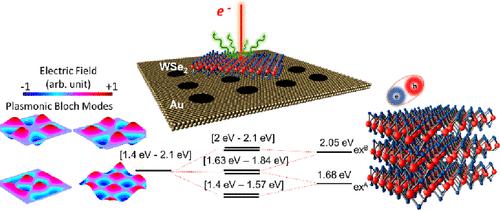当前位置:
X-MOL 学术
›
ACS Photonics
›
论文详情
Our official English website, www.x-mol.net, welcomes your
feedback! (Note: you will need to create a separate account there.)
Tailoring the Band Structure of Plexcitonic Crystals by Strong Coupling
ACS Photonics ( IF 6.5 ) Pub Date : 2022-06-14 , DOI: 10.1021/acsphotonics.2c00586 Fatemeh Davoodi 1 , Masoud Taleb 1 , Florian K. Diekmann 1 , Toon Coenen 2 , Kai Rossnagel 1, 3, 4 , Nahid Talebi 1, 4
ACS Photonics ( IF 6.5 ) Pub Date : 2022-06-14 , DOI: 10.1021/acsphotonics.2c00586 Fatemeh Davoodi 1 , Masoud Taleb 1 , Florian K. Diekmann 1 , Toon Coenen 2 , Kai Rossnagel 1, 3, 4 , Nahid Talebi 1, 4
Affiliation

|
Transition-metal dichalcogenides with their exciton-dominated optical behavior emerge as promising materials for realizing strong light–matter interactions in the visible range and at ambient conditions. When these materials are combined with metals, the energy confining ability of plasmon polaritons in metals below the diffraction limit allows for further enhancing and tailoring the light–matter interaction due to the formation of plexcitons in hybrid metal-TMDC structures at the interface. Herein, we demonstrate that the coupling between quasi-propagating plasmons in plasmonic crystals and excitons in WSe2 provides a multioscillator playground for tailoring the band structure of plasmonic crystal structures and results in emerging flat bands. The cathodoluminescence spectroscopy and angle-resolved measurements combined with the numerically calculated photonic band structure confirm a strong exciton–plasmon coupling, leading to significant changes in the band diagram of the hybrid lattice and the ability to tailor the band diagram via strong coupling. The hybrid plexcitonic crystal structures investigated here sustain optical waves with remarkably low group velocities. These results could be used for designing tunable slow-light structures based on the strong coupling effect and pave the way for plexcitonic topological photonic structures.
中文翻译:

通过强耦合调整丛子晶体的能带结构
具有以激子为主的光学行为的过渡金属二硫属化物成为在可见光范围和环境条件下实现强光-物质相互作用的有前途的材料。当这些材料与金属结合时,由于在界面处混合金属-TMDC结构中形成丛子,等离子激元在金属中低于衍射极限的能量限制能力允许进一步增强和调整光-物质相互作用。在这里,我们证明了等离子体晶体中的准传播等离子体与 WSe 2中的激子之间的耦合为定制等离子体晶体结构的能带结构提供了一个多振荡器操场,并导致新兴的平带。阴极发光光谱和角度分辨测量与数值计算的光子能带结构相结合,证实了强激子-等离子体耦合,导致混合晶格能带图发生显着变化,并能够通过强耦合调整能带图。这里研究的混合丛子晶体结构维持具有非常低的群速度的光波。这些结果可用于基于强耦合效应设计可调谐慢光结构,并为丛子拓扑光子结构铺平道路。
更新日期:2022-06-14
中文翻译:

通过强耦合调整丛子晶体的能带结构
具有以激子为主的光学行为的过渡金属二硫属化物成为在可见光范围和环境条件下实现强光-物质相互作用的有前途的材料。当这些材料与金属结合时,由于在界面处混合金属-TMDC结构中形成丛子,等离子激元在金属中低于衍射极限的能量限制能力允许进一步增强和调整光-物质相互作用。在这里,我们证明了等离子体晶体中的准传播等离子体与 WSe 2中的激子之间的耦合为定制等离子体晶体结构的能带结构提供了一个多振荡器操场,并导致新兴的平带。阴极发光光谱和角度分辨测量与数值计算的光子能带结构相结合,证实了强激子-等离子体耦合,导致混合晶格能带图发生显着变化,并能够通过强耦合调整能带图。这里研究的混合丛子晶体结构维持具有非常低的群速度的光波。这些结果可用于基于强耦合效应设计可调谐慢光结构,并为丛子拓扑光子结构铺平道路。









































 京公网安备 11010802027423号
京公网安备 11010802027423号